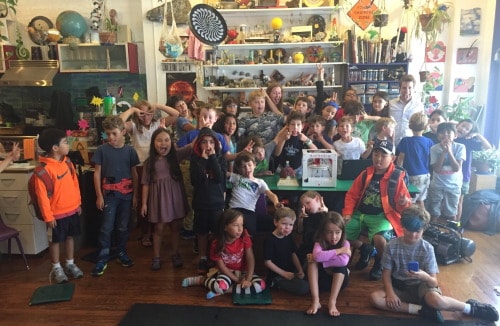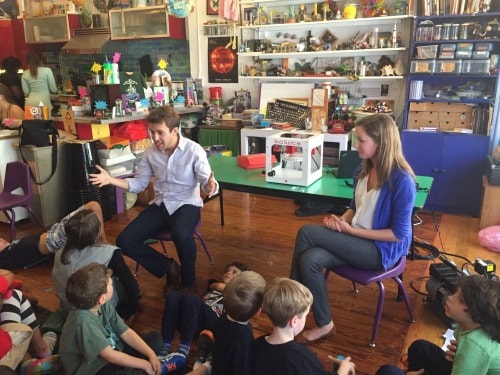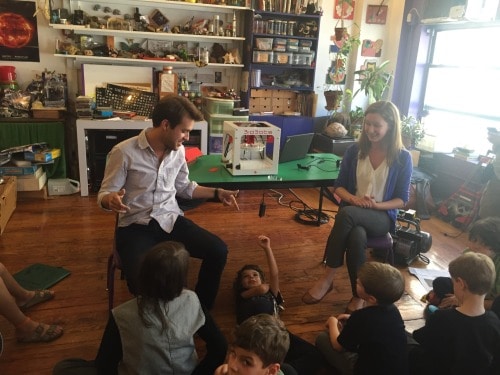
Allevi Blog
Clone Armies and the Squishy Things Inside of Us: 7-year-olds Learn to Engineer Biology
- Updated on February 27, 2020

Clone Armies and the Squishy Things Inside of Us: 7-year-olds Learn to Engineer Biology…
At Allevi, we’ve been accused of living in tomorrow’s world – and with the self-stated purpose of curing disease, eliminating the organ waiting list, reverting climate change and making life for humans on other planets possible, – it’d be a hard point to contest. We just can’t help ourselves.
As kids, we grow up dreaming of the future we might one day find ourselves in, and in an inevitable sense, we all find ourselves in a future of one shape or another. But just where we end up tomorrow starts with the actions we take today – and when the future you want seems an impossible dream, you have to start somewhere.
In New York City, the Science Adventure Kids are a precocious group of 5-12 year olds that could one day be tomorrow’s great doctors, engineers, and scientists. They are the ones who will inherit the future we’re building today, and the ones who will see it through to the next impossible possibility.
Their classroom is a playground for curiosity – their teacher – Science Teacher Sarah, a real life Ms. Frizzle. There are fossils and planetary models, a small zoo with snakes and turtles, a dark room glowing in a perpetual light show, and even a small backyard (for “blowing stuff up” – of course.) Last week they explored the middle ages, today they’re getting a visit from R2D2 – it seemed only fitting that we’d find ourselves somewhere in between.

Today’s 7-year-old is a technological marvel. In a world where many adults are just coming to grips with the possibilities of 3D printing to revolutionize human life across industries, there’s a kid in the room who’s already designed and printed his own NERF gun on TinkerCAD – much to Hasbro’s chagrin, perhaps. Here we are printing pediatric bronchi, layer by layer in a room full of Lego builders, and while one kid is particularly concerned we might start a fire, most look on with as much acceptance as amazement.
“That thing is alive inside me right now?!” says one student looking at the squishy structure assembling itself on the plate, as others move in for a look.
“Can you print a human? Can you print a clone of me now? Can we build a whole clone army??” Taking a step back, maybe… Is there what 7-year-olds imagine when they learn to engineer biology??
“Think, the great wall of china was built brick by brick,” Science Teacher Sarah interjects. “Now imagine asking to build an entire world out of that one brick. That is what it would take to build an entire human. So, we are a pretty long ways away.”
Pensive silence, if only momentary, then the promise of a robot army as a nearer possibility and the “oohs” and “ahhs” return, alleviating concerns that an exciting future is still close enough at hand.
A cell being established as the building block in question, the inquisition continues…

“Where do you get a cell?”
“We get them from you if we need to, but we get them from donors. And from their organs depending on which type of tissues we are trying to create.”
“Can I sneeze in the tissue?” A mix of laughter and a few thoughtful stabs at correction erupts.
“What types of tissues can you think of in the body?”
“Ear! Lung! Brain! Heart!” goes the chorus.
“Why can’t you build big tissues?”
“The limiting problem of vasculature, the tubes that take things in and out of the tissue. We need it just like the cities need roads to be able to get waste out and food back in.”
“What do you do with the small tissues?”
“We can test drugs to treat different diseases on these small parts of the tissue.”
Science Teacher Sarah demonstrates that she has asthma, for example, and that we could think about testing an asthma drug on her printed lung tissue.
“Out of a few cells, how many organs can you make?”
“Everyone came from a single cell so all of you now are created from that single cell because it divided. So we can take a few cells from you, grow a lot of them, and make entire organs out of them.”
The children ask, if not a whole person which parts could be made?
“Could you print a whole arm?”
One child, who had lost a portion of his forearm, mentions that he knew that customized plastic prosthetics could be made through 3D printing processes (such as the Enable Project.)
The ability to build living prosthetic structures from patient cells to replace lost limbs and other organs is a promising if still distant application to transform daily life for thousands of people. We say we hope we’ll be able to do it with biology in the future. It was great to see their 7-year-old minds learn the tenets of how to engineer biology.
Overall the session lasted about half an hour, and tired bodies slowly began to flop about the floor to process these latest developments. In an industry just in its nascence, with the potential to revolutionize human life across many industries, these children and their generation will be the ones to reap it’s greatest rewards. For now, we were happy to leave them with a smile.

